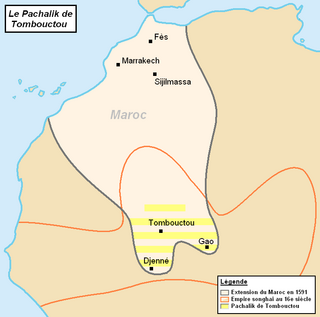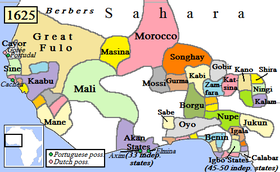
The Songhai Empire was a state located in the western part of the Sahel during the 15th and 16th centuries. At its peak, it was one of the largest African empires in history. The state is known by its historiographical name, derived from its largest ethnic group and ruling elite, the Songhai people. Sonni Ali established Gao as the empire's capital, although a Songhai state had existed in and around Gao since the 11th century. Other important cities in the kingdom were Timbuktu and Djenné, where urban-centred trade flourished; they were conquered in 1468 and 1475, respectively. Initially, the Songhai Empire was ruled by the Sonni dynasty, but it was later replaced by the Askia dynasty (1493–1901).

The Songhai people are an ethnolinguistic group in West Africa who speak the various Songhai languages. Their history and lingua franca is linked to the Songhai Empire which dominated the western Sahel in the 15th and 16th century. Predominantly adherents of Islam, the Songhai are primarily located in Niger and Mali within the Western Sudanic region. Historically, the term "Songhai" did not denote an ethnic or linguistic identity but referred to the ruling caste of the Songhay Empire known as the Songhaiborai. However, the correct term used to refer to this group of people collectively by the natives is "Ayneha". Although some Speakers in Mali have also adopted the name Songhay as an ethnic designation, other Songhay-speaking groups identify themselves by other ethnic terms such as Zarma or Isawaghen. The dialect of Koyraboro Senni spoken in Gao is unintelligible to speakers of the Zarma dialect of Niger, according to at least one report. The Songhay languages are commonly taken to be Nilo-Saharan but this classification remains controversial: Dimmendaal (2008) believes that for now it is best considered an independent language family.

The Sahelian kingdoms were a series of centralized kingdoms or empires that were centered on the Sahel, the area of grasslands south of the Sahara, from the 8th century to the 19th. The wealth of the states came from controlling the trade routes across the desert. Their power came from having large pack animals like camels and horses that were fast enough to keep a large empire under central control and were also useful in such kind of battle. All of these empires were also quite decentralized with member cities having a great deal of autonomy.

Askia Muhammad I (1443–1538), born Muhammad ibn Abi Bakr al-Turi or Muhammad Ture, was the first ruler of the Askia dynasty of the Songhai Empire, reigning from 1493 to 1528. He is also known as Askia the Great, and his name in modern Songhai is Mamar Kassey. Askia Muhammad strengthened his empire and made it the largest empire in West Africa's history. At its peak under his reign, the Songhai Empire encompassed the Hausa states as far as Kano and much of the territory that had belonged to the Songhai empire in the east. His policies resulted in a rapid expansion of trade with Europe and Asia, the creation of many schools, and the establishment of Islam as an integral part of the empire.
Taghaza is an abandoned salt-mining centre located in a salt pan in the desert region of northern Mali. It was an important source of rock salt for West Africa up to the end of the 16th century when it was abandoned and replaced by the salt-pan at Taoudenni which lies 150 km (93 mi) to the southeast. Salt from the Taghaza mines formed an important part of the long distance trans-Saharan trade. The salt pan is located 857 km (533 mi) south of Sijilmasa, 787 km (489 mi) north-northwest of Timbuktu and 731 km (454 mi) north-northeast of Oualata.

Gao, or Gawgaw/Kawkaw, is a city in Mali and the capital of the Gao Region. The city is located on the River Niger, 320 km (200 mi) east-southeast of Timbuktu on the left bank at the junction with the Tilemsi valley.
The Battle of Tondibi was the decisive confrontation in the 16th-century invasion of the Songhai Empire by the army of the Saadi dynasty in Morocco. Though vastly outnumbered, the Moroccan forces under Judar Pasha defeated the Songhai Askia Ishaq II, guaranteeing the empire's downfall.
Askia Ishaq II was ruler of the Songhai Empire from 1588 to 1591.

Askia Mohammad Benkan, also Askiya Muhammad Bonkana, was the third ruler of the Songhai Empire from 1531 to 1537.
The Askiya dynasty, also known as the Askia dynasty, ruled the Songhai Empire at the height of that state's power. It was founded in 1493 by Askia Mohammad I, a general of the Songhai Empire who usurped the Sonni dynasty. The Askiya ruled from Gao over the vast Songhai Empire until its defeat by a Moroccan invasion force in 1591. After the defeat, the dynasty moved south back to its homeland and created several smaller kingdoms in what is today Songhai in south-western Niger and further south in the Dendi.
The Arma people are an ethnic group of the middle Niger River valley, descended from Moroccan invaders of the 16th century. The name, applied by other groups, derives from the word ar-rumah "fusiliers".

Askia Ishaq I was the ruler of the Songhai Empire from 1539 to 1549, elected Askia following the death of Askia Isma'il. He was the fifth ruler of the Askiya dynasty which had the town of Gao as its capital.

The Battle of Jenné was a military engagement between forces of the Mali Empire and the Moroccan Pashalik of Timbuktu. The battle marked the effective end of the great Mali Empire and set the stage for a plethora of smaller West African states to emerge.

The Pashalik of Timbuktu, also known as the Pashalik of Sudan, was a West African political entity that existed between the 16th and the 19th century. It was formed after the Battle of Tondibi, when a military expedition sent by Saadian sultan Ahmad al-Mansur of Morocco defeated the Songhai Empire and established control over a territory centered on Timbuktu. Following the decline of the Saadi Sultanate in the early 17th century, Morocco retained only nominal control of the Pashalik.

Askia Daoud was the ruler of the Songhai Empire from 1549 to 1582. Daoud came to power unopposed following the death of his brother Askia Ishaq I in 1549. The Empire continued to expand under Daoud's peaceful rule, and saw little internal strife, until the invasion and interference of the Moroccan forces, which led to the empire's downfall in 1591.

The Songhai, ) is an area in the northwestern corner of Niger's Tillabéri Region populated mainly by the Songhaiborai. It is considered the heartland of the Songhai people and the sanctuary of their ancient pantheon and priestly class and the place in which the original lineage of the Sonni dynasty retreated after the coup d'etat of 1493 creating a secret society of magicians, the Sohance.

The Songhaiborai are a distinct subgroup within the larger Songhai ethnolinguistic family. Residing predominantly in Niger's Songhai region, Northern Mali, and a minority presence in Burkina Faso. Notably, they trace their lineage to the ruling dynasties of the ancient Songhai Empire.
The Moroccan invasion of the Songhai Empire began with an expedition sent in 1590 by Sultan Ahmad al-Mansur of the Saadian dynasty, which ruled over Morocco at the time. The Saadian army, led by Judar Pasha, arrived in the Niger valley region in 1591 and won its first and most decisive victory against the forces of Askia Ishaq II at the Battle of Tondibi and occupied the capital of Gao shortly after.
Lulami was the capital of the Dendi of the Songhai Empire. It was established by Askia Nuh, son of Askia Dawud and it is from here the Songhai resistance against Morocco continued. In 1639 during the reign of Askia Ismail, the Moroccan Pasha Mesaoud sacked the town of Lulami. The location of this town is unknown but believed to be south of the town of Say in Niger.
Askia Nuh was a ruler of the Dendi Kingdom, the rump state of the Songhai Empire. He was a son of Askia Dawud and established his capital at Lulami, from where Songhai resistance to the Saadi Moroccans continued.









